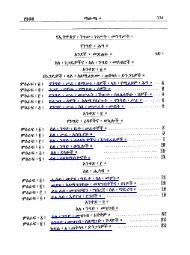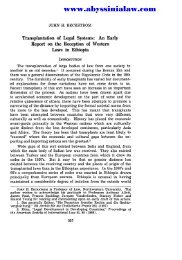Download - Abyssinia Law
Download - Abyssinia Law
Download - Abyssinia Law
Create successful ePaper yourself
Turn your PDF publications into a flip-book with our unique Google optimized e-Paper software.
Vol. 40, No. I Tort law and development<br />
www.abyssinialaw.com<br />
Colonial law was then, at least partially, superimposed on both these layers. 22<br />
On top of this, the law of the modem independent state (socialist during the<br />
period 1974-91) created a new layer. 23 No legal order had enough power<br />
completely to supplant previous layers, and legal scholars had little influence on<br />
the development of the phenomenon. Secondly, even the customary informal<br />
legal system resulted from a historical process of superimposition and integration<br />
of different components. What is usually referred to as the customary layer is<br />
made up of heterogeneous customs which interacted with each other historically.<br />
Though the absence of written sources makes it difficult to know the exact details<br />
of the history of the different ethnic groups, it is known that they experienced<br />
migrations, conquests and invasions which modified the customs of both the<br />
victorious and defeated groups. This phenomenon is neither structurally different<br />
nor less complex than the processes that took place in Europe with the clash<br />
and interplay of the flux of different legal cultures. 2 "<br />
In this process of stratification, the imposition of a new legal system did not<br />
cancel out the old legal order, but instead cohabited with it, officially or<br />
unofficially. It restricted the application of the old law and modified it or was<br />
modified by it in turn. This coexistence of different legal orders created a<br />
remarkable legal pluralism in Ethiopia and Eritrea, as in many other African<br />
countries.6 Such pluralism, which may depend on the nature of the legal<br />
transaction (such as family law, customary or business law), 27 survived even when<br />
the Ethiopian state attempted to unify its law and disregard customary law. In<br />
fact the latter flourished de facto, since the state lacked sufficient resources to<br />
impose its own choice. 2<br />
One can say the same about the organization of justice. The judicial system<br />
is unified but, within it, different courts apply a different law (state law, customary<br />
law, Islamic law). The legal culture of the judge and even the process of selection<br />
may change depending on the law which is to be applied. 2 " All this, of course,<br />
is crucially important to an understanding of Ethiopian and Eritrean tort law.<br />
Modem law adopted a Western model proposed by Ren6 David when drafting<br />
the Ethiopian Civil Code (Chapter XIII, consisting of no fewer than 135 articles,<br />
22 For valuable remarks on this phenomenon see R. Sacco, "Diffusion at d6pfrissement des<br />
modles juridiques italiens en Afrique, notamment en Somalie", in G. Conac (ed.), Dynamiques et<br />
Fnalit&s des Droits Africaines, 1980, 26f; M. Guadagni, Ri Diritto dei Paesi Afticani Nella Letteratura<br />
Contemporanea, 1984, 27ff, 215ff.<br />
23 P. Brietzke, <strong>Law</strong>, Development and the Ethiopian Revolution, 1982;J. Vanderlinden, "Le droit de la<br />
revolution 6thiopienne", in Conac (ed.), op. cit., 331.<br />
24 Compare D. Haile, "<strong>Law</strong> and social change in Africa: preliminary look at the Ethiopian<br />
experience", (1973) 9 J.E.L 380ff; P.L. Strauss and M.R. Topping, "Decision trees", (1970) 7 j.E.L<br />
447ff T. Geraghty, "People, practice, attitudes and problems in the courts of Ethiopia", (1969) 6<br />
7.E.L 426ff. It seems, however, unlikely that the exporters and the drafters of legal models and<br />
codes failed to take these problems into consideration. What may be more likely is that this issue<br />
was underestimated by the various African intellectuals who gained power, who had studied overseas<br />
and come under the influence of "traditional" Western legal models; on this point see D. Haile,<br />
"Ethiopia", in M. Guadagni (ed.), Legal Scholarship in Africa, 1989, 29ff.<br />
1 See the works quoted above, nn. 19-20.<br />
26 On this phenomenon see for example, J. Griffith, "What is legal pluralism?" (1986) 24 J. Leg.<br />
Pluralism and Unoffixial Laur, S. Engle-Merry, "Legal pluralism", (1988) 22 <strong>Law</strong> and Soc. Rea 869.<br />
27 G. Krzeczunowicz, "Code and custom in Ethiopia", (1965) 2J7.E.L 425ff; and "A new legislative<br />
approach to customary law. The 'repeals' provision of the Ethiopian Civil Code of 1960", (1964) 1<br />
J.E-L 57ff.<br />
28 P. Brietzke, <strong>Law</strong> Development and Ethiopian Revolution, 1982, 82ff R. Sacco, Dinto in Africa<br />
(forthcoming).<br />
2 As far as Ethiopia and Eritrea are concerned, see for example, Haile, op. cit.; Strauss and<br />
Topping, op. cit.





